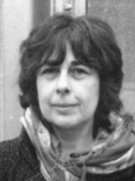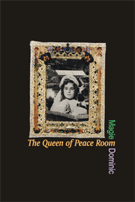 Magie Dominic Author of The Queen of Peace Room |
Introducing Magie Dominic... Magie Dominic was
born July 15, 1944 in Corner Brook Newfoundland. She studied at The Art
Institute of Pittsburgh; New School University; Franklin Furnace; Open
Theatre and with the founding members of the Off-Off Broadway movement.
Her writing and artwork have been published, printed, exhibited or
produced in over one hundred quarterlies, newspapers, magazines,
anthologies, theatre productions, librettos, art galleries and books.
One of the founding members of the Off-Off Broadway movement of the
sixties and a member of Poets Fast for Peace during the Vietnam War,
she has walked with Ginsberg, given poetry readings with Moondog,
written poetry, short stories, essays, and non-fiction, and developed a
creative writing curriculum for high school students at risk. Her art
work
includes installation, collage, illustration and photography and has
been exhibited in Toronto and New York, including a presentation at the
United Nations.
|
Awards/Grants
The Dakota Foundation New School University Faculty Development Fund Adolph & Esther Gottlieb Foundation Artists’ Fellowship The Shaker Foundation The Langston Hughes Award For Poetry |
 Queen of Peace Room Magie Dominic Wilfrid Laurier University Press (Ontario) Publication Date: October 2002 ISBN: 0-88920-417-9 $19.95 Paper, 130 pp. |
Synopsis In The Queen of Peace Room, from a very personal perspective, Magie Dominic explores violence against women in the second half of the twentieth century, and in doing so unearths the memory of a generation. In eight days, she captures half a century. In those eight days with Catholic nuns in a remote location safe from the outside world, Magie Dominic exposes, and captures, fifty years of violent memories and weaves them into a tapestry of unforgettable images. The room she inhabits while there is called The Queen of Peace Room; it becomes, for her, a room of sanctuary. She examines Newfoundland in the 1940s and 1950s and New York in the 1960s; her confrontations with violence, incest, and rape; the devastating loss of friends to AIDS; and the relationship between life and art. These memories she finds stored alongside memories of nature's images of trees pulling themselves up from their roots and fleeing the forest; storms and ley lines, and skies bursting with star-like eyes. |
In The Queen of Peace Room, Magie
Dominic puts her guts on every page without being mawkish, with
sentiment, but without sentimentality. You'll love this book. —Donald Forst,
editor-in-chief,
The Village Voice Dominic electrifies the pages. Her resolute voice is one that should definitely be heard. —Gay and Lesbian Review
Worldwide
The Queen of Peace Room is expansive life writing. The tragedy bound in this tale is epic. Yet, there is affirmation in Magie Dominic and in her story. The refusal of one human soul to let go of its dignity, its absolute unwillingness to surrender, is genuinely heroic. —Amazon.com/Borders.com,
Timothy E. McMahon, M.S. The Queen of Peace Room is an original, instructive and powerful book. RainTaxi Review,
Thomas Haley.
Despite the sometimes horrifying subject matter, Dominic's writing skill provides a balm which lifts this memoire into the extraordinary. —Dione M. Coumbe,
Editor, www.BookPublicity.co.uk
|
| Queen of Peace Room nominated for The Judy Grahn Award for best lesbian non-fiction as well as Book of the Year Award by ForeWord Magazine | ||
| From Wilfrid Laurier
University Press an Interview with Magie Dominic The Queen of Peace Room In your book you write about childhood in Newfoundland, about incest and rape, the anti-war movement and New York in the 1960's, about AIDS, about single parenthood. You also write about an isolated retreat house and ley lines. Why did you call the book The Queen of Peace Room and was it always called The Queen of the Peace Room? No, originally it was called ``Green Beans.'' A friend gave me an Xeroxed copy of a story she's read about a woman who'd overcome very hard times. She gave me only the last page in the story. The first two words on the Xeroxed page were the final two words in the last sentence from the previous page, ``....green beans.'' It represented the end of one thing and the beginning of something else. The two words meant a great deal to me but unfortunately they meant nothing to anyone else. So I changed it to The Queen of Peace Room because the story was captured in that exact room and on the grounds where the room existed. I truly believe that there are unseen energies on this earth, and if we're fortunate enough to connect with them, anything is possible - seeing into the future, healing from the past, addressing the present. It's a limitless form of energy and our only role is to be open to it and the beauty of the world around us, despite the bombers and machines of destruction. Recently I read this question in a book, ``Would the birds sing more if they knew we were listening?'' I believe earth is a presence filled with questions and answers. All we have to do is listen. While on retreat in an isolated house in the woods, amid the possible presence of ley lines, in a room called The Queen of Peace, I listened, and heard my own story. What was your intention in writing this book, what was the catalyst? In 1994 I wrote an autobiographical poem that was published in ARC quarterly. I wrote the poem as the singular voice of one woman and I allowed her to speak openly about her life. I received letters from people saying that I'd given a voice to the voiceless. The editor of ARC , John Barton, a Canadian poet for whom I have great respect, urged me to write the story of the poem. It seemed too much at the time, I'd just gotten the poem written and it was painful writing. But it was his initial encouragement and the encouragement of other Canadian poets that resulted in my beginning to document nearly half a century of violence. Then while on an unexpected retreat with a group of Catholic nuns, a moment of unbelievable love happened, an unbelievable outpouring of kindness that ultimately overpowered all of the violence and made the writing of the book possible. Do you think people have themselves to blame in any way for traumatic events of the past? Blame is a terrible word, especially when it applies to incest or rape. Blame is a damaging approach to take I think. In the book I refer to an incident involving incest. If we are of the belief that the violence of our childhood is of our own making and the people who inflicted the violence are never to be questioned or held accountable, then we will be forever silenced, which is a another form of violence against self. Violence happens, whether it's a bruise, a violent exchange of words or a violent attitude. It happens and it's occurring today with alarming frequency, especially against women. It is these experiences with violence, from a very personal perspective, that I'm attempting to articulate and the miracle of escaping the madness. You refer to trees often in the book, as if they're symbolic of something else, as if they have a very spiritual quality about them. Can you give an example of how trees have been symbolic in your own life? To me, trees are living, breathing friends. Community in the best sense of the word. We are all, despite what people may tell us, travelers on this road of life together, plant and animal alike. The tree is just as grateful for the rain as you or I may be. It will grow old and creak if given the opportunity. There was a giant tree outside my apartment window at one time; it filled the entire window space. During the year I had a terrible accident and was recovering from facial reconstruction, it seemed that every few months my face was different. And in reality every few months the tree was different. The tree changed right along with me. I will always be very grateful to that tree. How long have you been working on this book and what was the most difficult part to write? In my mind, I feel as if I've been writing it all my life, sometimes just a few pages a year. The creative mind has a will of its own I think, it finds a way to be placed on paper. I walked in a lot of quiet places. Being in touch with nature is a very powerful tool. Possibly one of the most powerful tools available to humanity. Epilepsy and the impact it's had on my life was definitely the most difficult part to write. Society, even today, despite technological advances, is armed with much inaccurate, harmful information. This will ultimately change, but the change will probably be gradual. |
| Home
• Issue 9 Front
Page • Newsletter Archives
• Article Archives
Page 2
|